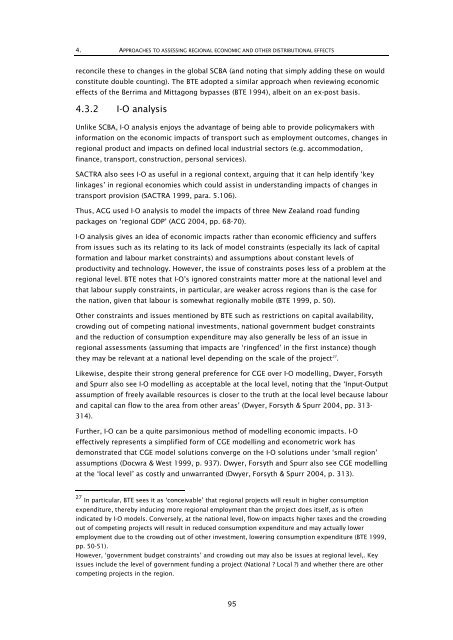Research 350 - NZ Transport Agency
Research 350 - NZ Transport Agency
Research 350 - NZ Transport Agency
Create successful ePaper yourself
Turn your PDF publications into a flip-book with our unique Google optimized e-Paper software.
4. APPROACHES TO ASSESSING REGIONAL ECONOMIC AND OTHER DISTRIBUTIONAL EFFECTS<br />
reconcile these to changes in the global SCBA (and noting that simply adding these on would<br />
constitute double counting). The BTE adopted a similar approach when reviewing economic<br />
effects of the Berrima and Mittagong bypasses (BTE 1994), albeit on an ex-post basis.<br />
4.3.2 I-O analysis<br />
Unlike SCBA, I-O analysis enjoys the advantage of being able to provide policymakers with<br />
information on the economic impacts of transport such as employment outcomes, changes in<br />
regional product and impacts on defined local industrial sectors (e.g. accommodation,<br />
finance, transport, construction, personal services).<br />
SACTRA also sees I-O as useful in a regional context, arguing that it can help identify ‘key<br />
linkages’ in regional economies which could assist in understanding impacts of changes in<br />
transport provision (SACTRA 1999, para. 5.106).<br />
Thus, ACG used I-O analysis to model the impacts of three New Zealand road funding<br />
packages on ‘regional GDP’ (ACG 2004, pp. 68-70).<br />
I-O analysis gives an idea of economic impacts rather than economic efficiency and suffers<br />
from issues such as its relating to its lack of model constraints (especially its lack of capital<br />
formation and labour market constraints) and assumptions about constant levels of<br />
productivity and technology. However, the issue of constraints poses less of a problem at the<br />
regional level. BTE notes that I-O’s ignored constraints matter more at the national level and<br />
that labour supply constraints, in particular, are weaker across regions than is the case for<br />
the nation, given that labour is somewhat regionally mobile (BTE 1999, p. 50).<br />
Other constraints and issues mentioned by BTE such as restrictions on capital availability,<br />
crowding out of competing national investments, national government budget constraints<br />
and the reduction of consumption expenditure may also generally be less of an issue in<br />
regional assessments (assuming that impacts are ‘ringfenced’ in the first instance) though<br />
they may be relevant at a national level depending on the scale of the project 27 .<br />
Likewise, despite their strong general preference for CGE over I-O modelling, Dwyer, Forsyth<br />
and Spurr also see I-O modelling as acceptable at the local level, noting that the ‘Input-Output<br />
assumption of freely available resources is closer to the truth at the local level because labour<br />
and capital can flow to the area from other areas’ (Dwyer, Forsyth & Spurr 2004, pp. 313-<br />
314).<br />
Further, I-O can be a quite parsimonious method of modelling economic impacts. I-O<br />
effectively represents a simplified form of CGE modelling and econometric work has<br />
demonstrated that CGE model solutions converge on the I-O solutions under ‘small region’<br />
assumptions (Docwra & West 1999, p. 937). Dwyer, Forsyth and Spurr also see CGE modelling<br />
at the ‘local level’ as costly and unwarranted (Dwyer, Forsyth & Spurr 2004, p. 313).<br />
27 In particular, BTE sees it as ‘conceivable’ that regional projects will result in higher consumption<br />
expenditure, thereby inducing more regional employment than the project does itself, as is often<br />
indicated by I-O models. Conversely, at the national level, flow-on impacts higher taxes and the crowding<br />
out of competing projects will result in reduced consumption expenditure and may actually lower<br />
employment due to the crowding out of other investment, lowering consumption expenditure (BTE 1999,<br />
pp. 50-51).<br />
However, ‘government budget constraints’ and crowding out may also be issues at regional level,. Key<br />
issues include the level of government funding a project (National ? Local ?) and whether there are other<br />
competing projects in the region.<br />
95
















